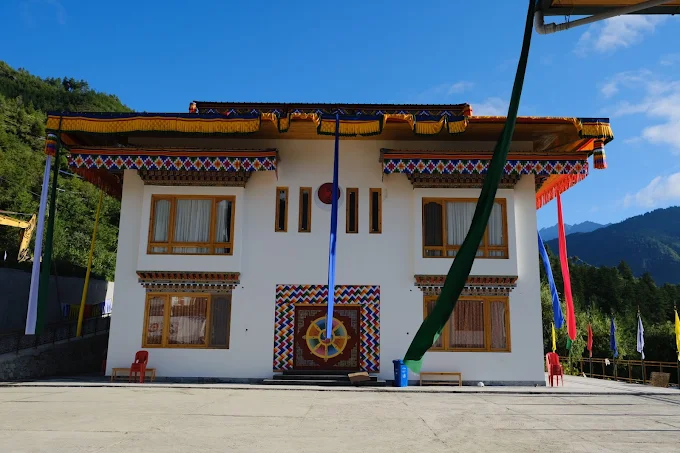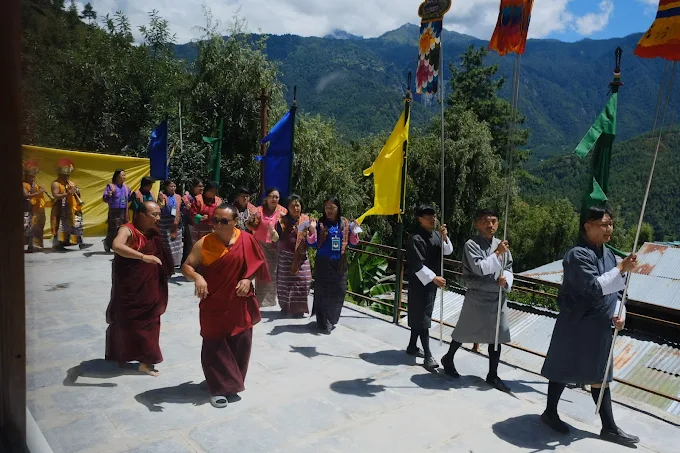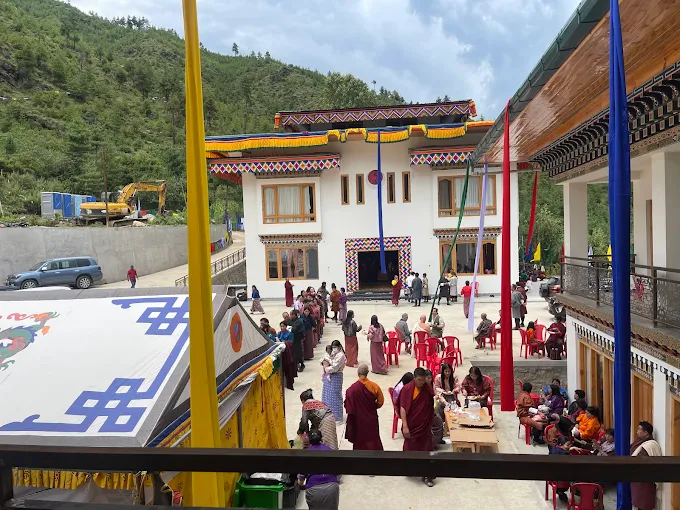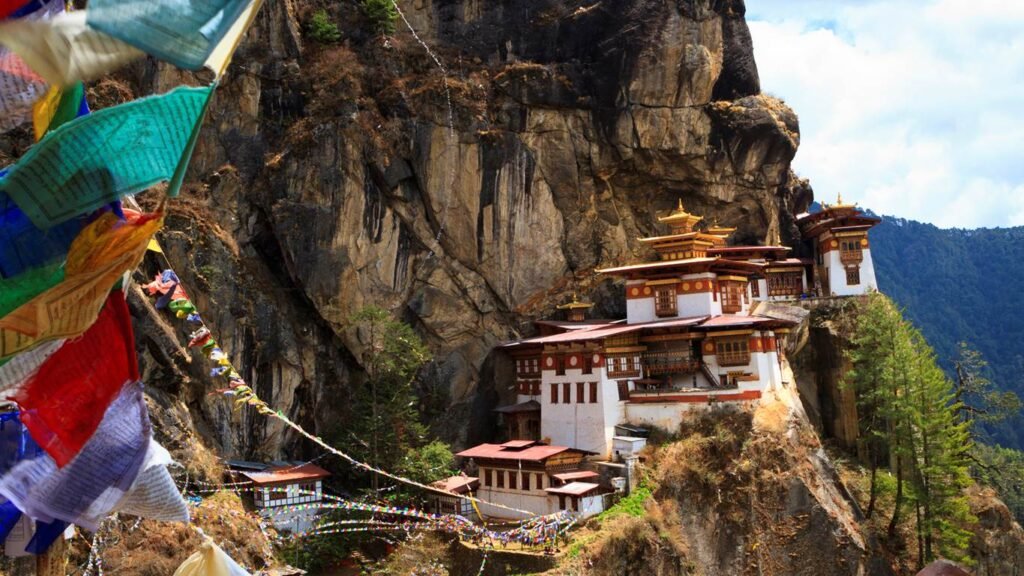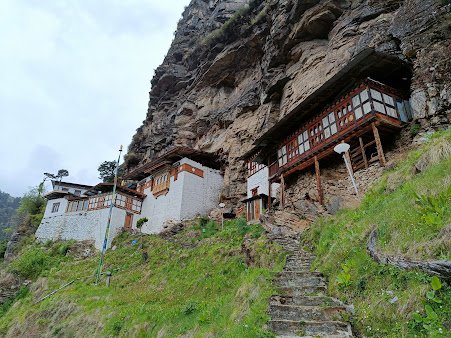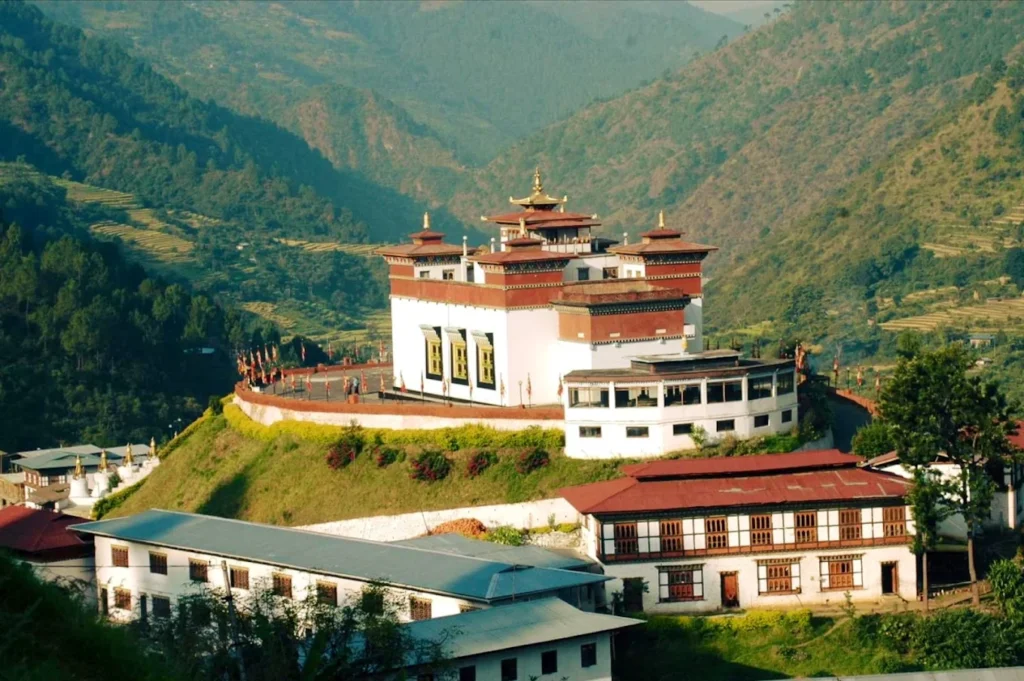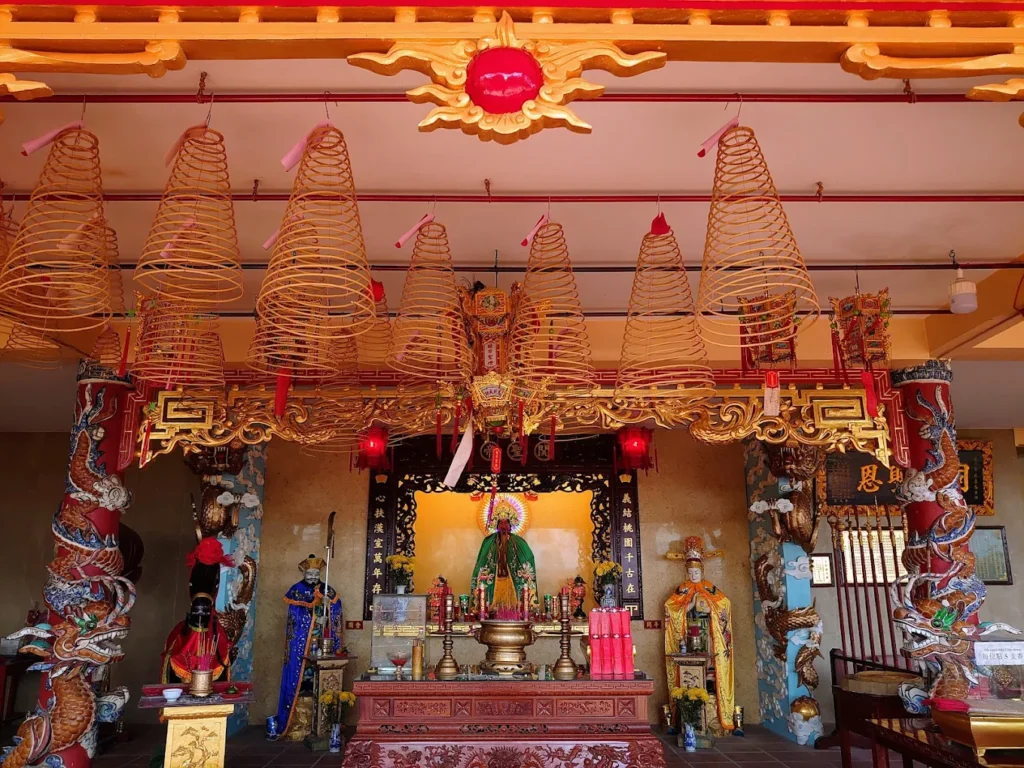Drikung Dorji Thekchokling Monastery: Kagyu Beacon of Paro’s Sacred Valley
As dawn spills over Paro Valley’s jagged cliffs, Drikung Dorji Thekchokling Monastery stirs on a ridge near Paro Taktsang, its whitewashed walls aglow with the first alpine light. Within the prayer hall, a towering bronze Shakyamuni Buddha stands beside Guru Rinpoche and Kyobpa Jigten Sumgön, their forms framed by swirling Karma Ghadri murals of lotus and cloud motifs, as butter lamps pulse with the rhythm of monks’ chants. Across the valley, Paro Taktsang’s golden roofs shimmer, a sacred echo to Drikung’s meditative calm. During the spring Tshechu, masked dancers weave through the courtyard, their vibrant steps tracing the Drikung Kagyu lineage’s ancient wisdom. Established after 2010, possibly tied to Kagyu Shedrupling Institute’s mission to educate young monks, this monastery in Dopshari Gewog serves Paro’s Sharchop community as a spiritual and learning hub. Perched amid pine-fringed slopes, it blends Mahamudra meditation with Bhutanese artistry, offering a sanctuary where Kagyu teachings meet Paro’s timeless serenity.
Overview and Significance
Drikung Dorji Thekchokling Monastery rises as a modern sentinel in Paro Valley, its golden chorten and prayer halls facing the revered cliffs of Paro Taktsang. Rooted in the Drikung Kagyu lineage, it weaves a rich tapestry of history, spiritual devotion, and community vitality, anchoring Bhutan’s sacred heritage.
Historical Roots and Legacy
In the heart of Paro’s highlands, Drikung Dorji Thekchokling Monastery emerged after 2010, possibly as part of Kagyu Shedrupling Institute’s vision to nurture young monks from humble backgrounds. The Drikung Kagyu lineage, founded in 1179 by Kyobpa Jigten Sumgön in Tibet, arrived in Bhutan through Nyo Gyelwa Lhanangpa’s 13th-century fortress, Do Ngon Dzong, in Thimphu. This monastery, likely established with guidance from Drikung Kyabgon Chetsang, continues Jigten Sumgön’s teachings of Mahamudra and Phowa, emphasizing meditation and conscious dying. Its founding aligns with Bhutan’s 21st-century Kagyu revival, building on the lineage’s historical presence in Paro. Key milestones include:
- 13th-Century Roots: Nyo Gyelwa Lhanangpa’s Drikung teachings spread to western Bhutan.
- Post-2010 Founding: Likely tied to Shedrupling’s land acquisition, blessed by local lamas.
- Educational Mission: Supports monastic training, echoing Jigten Sumgön’s scholarly legacy.
- Cultural Continuity: Preserves Kagyu practices amid Paro’s sacred landscape.
Cultural and Spiritual Significance
The monastery stands as a spiritual cornerstone, transmitting Drikung Kagyu’s teachings to Paro’s Sharchop villagers and beyond. Its proximity to Paro Taktsang, Bhutan’s holiest site, amplifies its sanctity, drawing pilgrims seeking Mahamudra’s clarity. The monastery’s role in educating young monks reflects Bhutan’s commitment to preserving Buddhist scholarship while fostering compassion. It hosts vibrant festivals like Tshechu, where dances honor Kagyu masters, reinforcing cultural pride. Its significance includes:
- Kagyu Anchor: Upholds Mahamudra and Phowa, guiding practitioners to enlightenment.
- Cultural Hub: Tshechu and Monlam unite Paro’s community in devotion.
- Educational Role: Likely nurtures Shedrupling’s mission, training future lamas.
- Sacred Geography: Its Taktsang-facing ridge enhances its spiritual resonance.
Community and Global Connections
Drikung Dorji Thekchokling binds Paro’s Sharchop community through rituals and education, offering dharma classes and retreats that strengthen local faith. Its ties to Kagyu Shedrupling Institute suggest a focus on uplifting low-income youth, fostering social mobility through monastic training. Regionally, it draws Kagyu practitioners from western Bhutan, while its Drikung Kagyu lineage connects to global centers like Ladakh and the U.S. Anecdotes highlight its impact:
- Local Unity: Villagers organize Tshechu, weaving communal bonds.
- Global Reach: Drikung Kyabgon’s teachings inspire international pilgrims.
- Youth Empowerment: Shedrupling’s students lead prayers, a testament to education.
- Historical Echoes: Nyo Gyelwa’s legacy inspires Paro’s modern devotees.
The monastery’s legacy, rooted in Paro’s cliffs, sets the stage for its architectural splendor, where sacred spaces mirror its Kagyu heart.
Architectural and Spiritual Features
Drikung Dorji Thekchokling’s whitewashed halls and golden roofs rise against Paro’s alpine slopes, their design blending Bhutanese craftsmanship with Drikung Kagyu reverence. This section explores the monastery’s physical and spiritual essence, from its chorten to its sacred statues.
Iconic Design and Structures
The monastery’s stone walls, crowned with red-tiled roofs, perch on a ridge in Dopshari Gewog at 2,500 meters, their silhouette echoing Paro Taktsang’s distant cliffs. The main prayer hall, or lhakhang, spans a spacious chamber with intricately carved timber beams etched with “Om Mani Padme Hung,” while a golden chorten gleams at the entrance, catching the dawn’s alpine glow. The courtyard, fringed by prayer flags fluttering in the mountain breeze, offers sweeping views of Paro Valley’s pine-fringed slopes. Key structures include:
- Main Prayer Hall: A vaulted space with high ceilings, adorned with Karma Ghadri murals of lotus and cloud motifs, hosting daily chants.
- Golden Chorten: A stupa with a square base and spire, symbolizing enlightenment, anchoring the courtyard.
- Monks’ Quarters: A 2010 wing with simple rooms, expandable for growing novices.
- Meditation Cells: Secluded chambers for Mahamudra practice, tucked into the ridge.
Sacred Statues and Relics
The prayer hall houses a pantheon of revered statues, each crafted with bronze and gold inlay, embodying Drikung Kagyu’s spiritual core. The towering Shakyamuni Buddha, its serene gaze fixed in meditation, anchors the altar, flanked by Guru Rinpoche, whose Bhutanese features honor Paro’s Buddhist roots, and Kyobpa Jigten Sumgön, the Drikung Kagyu founder, depicted with a teaching mudra. Gampopa’s statue, a nod to Kagyu’s origins, completes the ensemble, while smaller icons of Avalokiteshvara and Green Tara adorn side altars. Key features include:
- Shakyamuni Buddha: A 3-meter bronze statue, symbolizing enlightenment, crafted in Thimphu.
- Guru Rinpoche: A 2-meter icon, embodying Bhutan’s spiritual founding.
- Kyobpa Jigten Sumgön: Honors the 1179 lineage with intricate detailing.
- Prayer Wheel Relics: Wooden wheels in the courtyard bear mantras, spun by pilgrims.
Artistry and Environmental Harmony
The monastery’s architecture reflects Bhutanese mastery, with seasoned timber beams carved by Paro artisans and stone walls quarried locally, blending durability with aesthetic grace. Karma Ghadri murals, painted with mineral pigments, depict Kagyu masters like Tilopa amid swirling clouds, their vibrant hues preserved against Paro’s humidity by annual maintenance. The ridge perch integrates the monastery with Paro’s cliffs, its chorten aligned with Taktsang’s silhouette, enhancing meditative serenity. Notable elements include:
- Artisan Craft: Paro carpenters etched mantra-laden beams; Thimphu painters crafted murals.
- Environmental Integration: The courtyard’s pines and valley views mirror Kagyu’s nature reverence.
- Preservation Efforts: Monks treat wood annually, safeguarding murals from dampness.
- Symbolic Design: Lotus motifs on walls echo purity, distinct from ritual symbolism.
The monastery’s sacred spaces, from chorten to prayer hall, cradle its rituals, drawing devotees into Drikung Kagyu’s meditative heart.
Rituals and Practices
Drikung Dorji Thekchokling’s rituals, steeped in the Drikung Kagyu lineage, weave chant, meditation, and festival traditions into a vibrant spiritual tapestry. This section explores the monastery’s ceremonial life, fostering enlightenment for monks and visitors alike.
Daily and Unique Rituals
Each dawn, monks gather in the prayer hall, their voices resonating with Kagyu sutras like the Heart Sutra, filling the air with a rhythmic hum as butter lamps cast a warm glow. Offerings of incense and water honor Shakyamuni and Jigten Sumgön, their fragrance mingling with the scent of polished wood. Mahamudra meditation sessions, held twice daily, guide monks to the mind’s innate clarity, while Phowa practice, unique to Drikung Kagyu, prepares practitioners for conscious dying, channeling compassion for all beings. Distinctive rites include:
- Torma Sculptures: Monks craft intricate dough offerings during Monlam, symbolizing impermanence.
- Morning Chants: Daily recitations of Gampopa’s texts, echoing Kagyu wisdom.
- Phowa Rituals: Weekly sessions led by senior lamas, unique to Drikung teachings.
- Incense Offerings: Daily rituals at the chorten, purifying the courtyard’s air.
Festival Traditions
The monastery comes alive during the spring Tshechu, held in March or April, when masked dancers perform cham dances in the courtyard, their vibrant costumes swirling to honor Tilopa and Jigten Sumgön. The annual Kagyu Monlam, a prayer festival for world peace, draws Paro’s villagers and regional pilgrims, with monks reciting aspirations under prayer flags. These festivals, rooted in Kagyu tradition, celebrate compassion and wisdom, distinct from daily rites. Key events include:
- Tshechu Dances: Honor Kagyu masters with lion and deer motifs, held in spring.
- Monlam Prayers: Chanted aspirations for peace, led by visiting lamas.
- Seasonal Offerings: Butter lamps multiply during Losar, marking the New Year.
- Community Feasts: Villagers share rice and ema datshi post-festivals.
Community and Visitor Engagement
Monks, led by senior lamas, guide daily rites and teach dharma to young novices, many from Shedrupling’s low-income families, fostering a cycle of learning and devotion. Paro’s Sharchop villagers organize Tshechu, weaving communal bonds through shared labor and prayer. Visitors can join morning chants, guided by monks, or participate in Monlam prayers, immersing in Kagyu’s meditative pulse. Engagement includes:
- Visitor Chants: Guests join dawn sutra recitations, learning Kagyu mantras.
- Festival Roles: Villagers prepare torma, inviting visitors to observe.
- Dharma Talks: Monks offer talks on Mahamudra, open to pilgrims.
- Community Unity: Sharchop families host post-Tshechu gatherings, welcoming travelers.
The monastery’s rituals, vibrant with Kagyu tradition, invite exploration of its sacred spaces, guiding visitors to Paro’s cultural and practical embrace.
Visitor Information
Drikung Dorji Thekchokling Monastery beckons travelers to Paro’s highlands, offering practical guidance to engage with its Kagyu heart, from navigating its ridge to immersing in its sacred rhythm.
Navigating the Monastery
Tucked in Paro Valley’s Dopshari Gewog, the monastery perches on a ridge facing Paro Taktsang’s iconic cliffs, a 1-hour drive from Paro town through pine-lined roads. From Dopshari village, a 15-minute trek winds past prayer flags, leading to the golden chorten that marks the monastery’s entrance. Landmarks include the distant spire of Paro Kyichu Temple, visible en route, and the ridge’s elephant-trunk shape, a nod to its sacred geography. Key navigational tips include:
- Route: Follow the Paro-Dopshari road, then trek from the village’s edge.
- Landmarks: Look for Taktsang’s cliffs and prayer flags guiding the path.
- Trekking Path: A gentle trail with stone markers, ideal for day hikes.
- Orientation: The chorten’s gleam signals the monastery from afar.
Practical Details and Etiquette
The monastery’s precise address is Paro Valley, Dopshari Gewog, Paro District, Bhutan, accessible daily from 7:00 AM to 5:00 PM, with extended hours during Tshechu. Visitors must dress modestly, covering shoulders and knees, and remove shoes before entering the prayer hall, respecting the sanctity of altars. Transport options include taxis from Paro town or buses to Dopshari, followed by a short walk. Accessibility and safety details ensure a smooth visit:
- Address: Paro Valley, Dopshari Gewog, Paro District, Bhutan.
- Hours: 7:00 AM–5:00 PM, extended for spring Tshechu and Monlam.
- Etiquette: Avoid photographing altars; speak softly during chants.
- Transport: Taxis (1-hour from Paro); buses to Dopshari, then 15-minute trek.
- Accessibility: Flat courtyard; steps limit prayer hall for mobility-impaired.
- Safety: Paro is safe; carry water and warm clothing for the trek.
Immersive Experiences and Surroundings
To deepen the visit, arrive at dawn for sutra chants, where monks’ voices blend with the scent of butter lamps, or join Monlam prayers for a meditative experience. The spring Tshechu offers vibrant cham dances, a spectacle of Kagyu heritage. Nearby, Paro Taktsang, a 5-km trek away, beckons as Bhutan’s holiest site, while Paro Kyichu Temple, 10 km away, offers 7th-century serenity. Dopshari village’s tea stalls provide local flavor, with ema datshi and butter tea. Immersive highlights include:
- Chanting Sessions: Join morning sutras for Kagyu insight.
- Tshechu Dances: Observe spring cham dances, honoring Jigten Sumgön.
- Nearby Sites: Trek to Paro Taktsang or visit Kyichu’s ancient altars.
- Local Flavor: Savor Sharchop dishes at Dopshari homestays.
The monastery’s gates open to its Kagyu philosophy, where Paro’s sacred wisdom unfolds in vibrant depth.
Cultural and Spiritual Insights
Drikung Dorji Thekchokling’s essence lies in its Drikung Kagyu roots and Paro’s sacred spirit, offering profound insights into Bhutan’s spiritual and cultural depth.
Philosophical Foundations
Drikung Kagyu’s teachings, rooted in Mahamudra and Phowa, guide monks toward enlightenment by realizing the mind’s innate clarity and preparing for conscious dying. Mahamudra, meaning “Great Seal,” emphasizes meditation to transcend dualistic thought, while Phowa transfers consciousness at death, reflecting compassion for all beings. These practices, transmitted by Kyobpa Jigten Sumgön since 1179, shape the monastery’s daily meditations, fostering a path to liberation accessible to novices and pilgrims alike. Key elements include:
- Mahamudra: Direct insight into the mind’s nature, practiced daily.
- Phowa: Unique Drikung ritual for compassionate death, taught weekly.
- Compassion Focus: Aligns with Kagyu’s emphasis on benefiting others.
Cultural and Symbolic Depth
The monastery’s Karma Ghadri murals, depicting Jigten Sumgön amid lotus and cloud motifs, symbolize enlightenment’s purity, distinct from ritual offerings like torma. The golden chorten, aligned with Paro Taktsang’s cliffs, embodies Kagyu’s reverence for sacred geography, its spire pointing to liberation. These artistic elements, crafted by Thimphu painters, reflect Bhutanese devotion, weaving Kagyu wisdom into Paro’s cultural fabric. Symbolic highlights include:
- Lotus Motifs: Represent purity rising from worldly strife.
- Chorten Symbolism: Embodies Buddha’s enlightened mind, a meditative focus.
- Kagyu Iconography: Murals of Tilopa link to lineage origins.
Community and Environmental Resilience
The monastery strengthens Paro’s Sharchop community through Tshechu and dharma classes, uplifting youth via Shedrupling’s educational mission. Villagers’ tree-planting around Dopshari reflects Bhutan’s eco-conscious ethos, aligning with Kagyu’s reverence for nature. Stories of monks mentoring local children highlight resilience, while the monastery’s ridge perch fosters harmony with Paro’s pines. Key aspects include:
- Community Bonds: Sharchop villagers organize festivals, fostering unity.
- Eco-Stewardship: Pine plantings honor Bhutan’s environmental values.
- Youth Upliftment: Shedrupling’s training shapes future lamas.
These insights weave a vibrant reflection on the monastery’s enduring role, beckoning travelers to its sacred embrace.
Why You Have to Get to Drikung Dorji Thekchokling Monastery
Drikung Dorji Thekchokling Monastery beckons as a Kagyu beacon in Paro’s sacred valley, its golden chorten and towering Shakyamuni statue radiating the wisdom of Jigten Sumgön’s 12th-century teachings. The spring Tshechu’s masked dances, swirling with lotus motifs, pulse with Mahamudra’s clarity, while daily chants echo across the ridge, facing Paro Taktsang’s hallowed cliffs. This modern sanctuary, possibly tied to Kagyu Shedrupling’s mission, nurtures Paro’s Sharchop youth, blending education with devotion amid pine-fringed slopes. From its Karma Ghadri murals to the meditative hum of Phowa rituals, it offers a rare chance to immerse in Bhutan’s living Kagyu heritage. Travelers are invited to pause where prayer flags dance, their colors weaving enlightenment into Paro’s timeless highlands.
